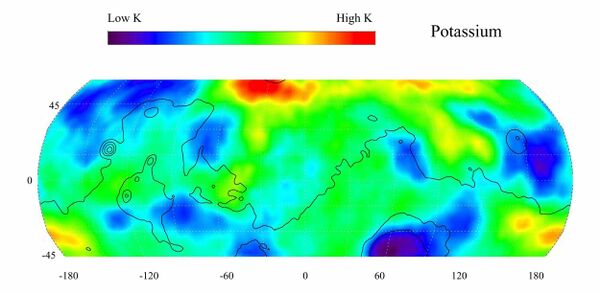Difference between revisions of "Potassium"
| (5 intermediate revisions by the same user not shown) | |||
| Line 4: | Line 4: | ||
|elementSymbol=K | |elementSymbol=K | ||
|protons=19 | |protons=19 | ||
| − | |abundance= | + | |abundance=2.6% |
}} | }} | ||
[[File:PIA04255 hires.jpg|thumb|600x600px|Mars Odyssey - Potassium abundance on Mars<ref>https://www.jpl.nasa.gov/spaceimages/details.php?id=PIA04255#:~:text=Potassium%2C%20having%20the%20chemical%20symbol,N%2C%20%2D30%20degrees).</ref>]] | [[File:PIA04255 hires.jpg|thumb|600x600px|Mars Odyssey - Potassium abundance on Mars<ref>https://www.jpl.nasa.gov/spaceimages/details.php?id=PIA04255#:~:text=Potassium%2C%20having%20the%20chemical%20symbol,N%2C%20%2D30%20degrees).</ref>]] | ||
| − | Potassium, ''[[Elements on Mars|periodic table]] K'', is a solid at room temperature. It's most common isotope is <sup>39</sup>K. | + | Potassium, ''[[Elements on Mars|periodic table]] K'', is a solid at room temperature. It's most common isotope is <sup>39</sup>K. <sup>40</sup>K is a radioactive isotope with a half life of 1.248×10<sup>9</sup> years. It's abundance can be measured remotely. Potassium is fairly abundant on the Martian surface, with a higher abundance than in Earth's crust, where it makes up about 2.6% of the weight of the crust and is the seventh most abundant element. |
| − | Potassium is | + | Potassium<ref>Wikipedia: https://en.wikipedia.org/wiki/Potassium</ref> is a [[Fertilizer|fertilizer.]] 95% of the production on Earth is for that purpose. Potassium is essential to humans as a part of the functions of cells, in particular nerve cells. |
| − | + | ==Mars Odyssey Potassium abundance map== | |
| + | This gamma ray spectrometer map of the mid-latitude region of Mars is based on gamma-rays from the <sup>40</sup>K isotope of Potassium that was measured by Mars Odyssey. | ||
| − | + | The region of highest potassium content, shown in red, is concentrated in the northern part of Acidalia Planitia (centered near 55 degrees N, -30 degrees). Several areas of low potassium content, shown in blue, are distributed across the mid-latitudes, with two significant low concentrations, one associated with the Hellas Basin (centered near 35 degrees S, 70 degrees) and the other lying southeast of Elysium Mons (centered near 10 degrees N, 160 degrees). Contours of constant surface elevation are also shown. The long continuous line running from east to west marks the approximate separation of the younger lowlands in the north from the older highlands in the south. | |
| − | + | ||
| + | ==Potassium resources== | ||
| + | Potassium should be available on Mars in evaporites, areas where water has evaporated leaving layers of various salts. | ||
==References== | ==References== | ||
<references /> | <references /> | ||
Latest revision as of 12:31, 7 May 2024
| K | 19 |
| Potassium | |
Abundance: 2.6%

Potassium, periodic table K, is a solid at room temperature. It's most common isotope is 39K. 40K is a radioactive isotope with a half life of 1.248×109 years. It's abundance can be measured remotely. Potassium is fairly abundant on the Martian surface, with a higher abundance than in Earth's crust, where it makes up about 2.6% of the weight of the crust and is the seventh most abundant element.
Potassium[2] is a fertilizer. 95% of the production on Earth is for that purpose. Potassium is essential to humans as a part of the functions of cells, in particular nerve cells.
Mars Odyssey Potassium abundance map
This gamma ray spectrometer map of the mid-latitude region of Mars is based on gamma-rays from the 40K isotope of Potassium that was measured by Mars Odyssey.
The region of highest potassium content, shown in red, is concentrated in the northern part of Acidalia Planitia (centered near 55 degrees N, -30 degrees). Several areas of low potassium content, shown in blue, are distributed across the mid-latitudes, with two significant low concentrations, one associated with the Hellas Basin (centered near 35 degrees S, 70 degrees) and the other lying southeast of Elysium Mons (centered near 10 degrees N, 160 degrees). Contours of constant surface elevation are also shown. The long continuous line running from east to west marks the approximate separation of the younger lowlands in the north from the older highlands in the south.
Potassium resources
Potassium should be available on Mars in evaporites, areas where water has evaporated leaving layers of various salts.






